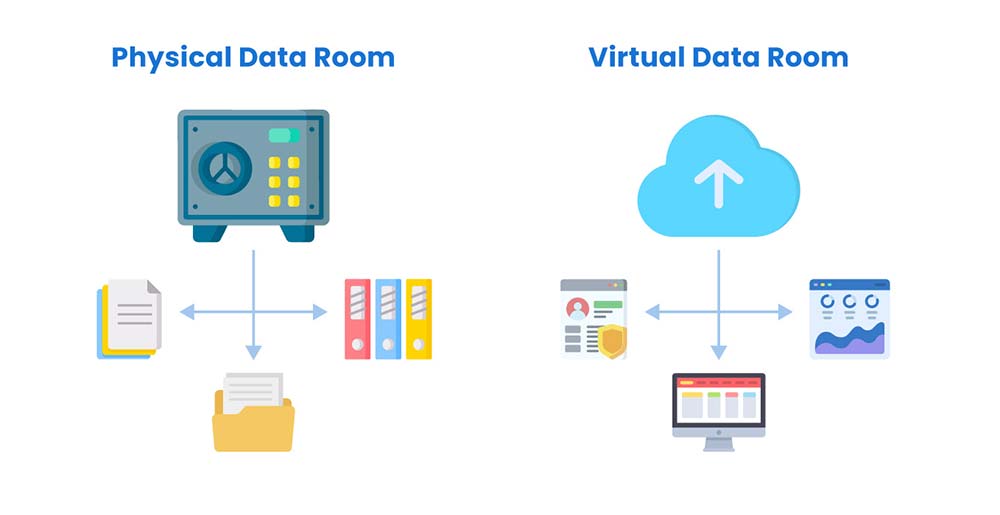In today’s rapidly evolving business environment, the choice between physical and virtual data rooms (VDRs) is crucial for managing sensitive information effectively. Both options offer distinct benefits and drawbacks, and understanding these can help businesses select the right solution for their needs. This article explores the advantages and disadvantages of physical data rooms and the rise of virtual data rooms, offering insights into how modern businesses are adapting to new data management trends.
Advantages and Disadvantages of Physical Data Rooms
Physical Data Room Benefits:
-
Tangible Security: Physical data rooms provide a controlled environment where access is strictly regulated. This can be particularly reassuring for businesses concerned about the physical security of their documents.
-
Direct Supervision: On-site management allows for hands-on control over document handling and security procedures, minimizing the risk of unauthorized access. With direct supervision, businesses can ensure that data security protocols are consistently enforced.
Physical Data Room Drawbacks:
-
Limited Accessibility: Physical data rooms restrict access to on-site visits, which can slow down the review process and limit collaboration opportunities, especially for remote or international teams. This limitation affects the efficiency of data security measures as physical presence is required for access.
-
High Costs: Maintaining a physical data room involves significant costs related to space, security, and personnel. These expenses can be prohibitive for smaller businesses. The costs associated with ensuring physical data security can outweigh the benefits, especially for companies with limited budgets.
The Rise of Virtual Data Rooms in Business
Virtual Data Rooms (VDRs) have emerged as a game-changer in data management software, offering several advantages over traditional physical data rooms:
Virtual Data Rooms:
-
Enhanced Accessibility: VDRs allow users to access documents from anywhere in the world, facilitating faster decision-making and collaboration among geographically dispersed teams.
-
Cost Efficiency: With no need for physical space or extensive security measures, VDRs significantly reduce operational costs. They also minimize the administrative burden associated with physical data rooms, improving overall business efficiency.
-
Advanced Security Features: Modern VDRs offer robust security measures, including encryption, multi-factor authentication, and detailed access controls. These features ensure that sensitive information is protected from unauthorized access.
Virtual Data Rooms (VDRs) revolutionize data management by offering enhanced accessibility, cost efficiency, and advanced security features. These benefits contribute to improved business efficiency and streamlined operations, making VDRs a superior choice for modern data management compared to traditional physical data rooms.
Trends in Data Management: Moving Towards Virtual Solutions

As businesses increasingly recognize the benefits of digital solutions, the trend is clearly shifting towards virtual data rooms. Key trends include:
-
Increased Adoption of Cloud Technology: Cloud-based VDRs provide scalable and flexible solutions for data management software, making them an attractive option for businesses looking to streamline operations and improve efficiency.
-
Integration with Business Tools: Many VDRs now integrate with other business software, such as project management and CRM systems, enhancing overall workflow and productivity. Explore the latest advancements in data room software in this article on data management trends.
-
Future of Data Rooms: The future of data rooms is leaning heavily towards virtual solutions, with ongoing innovations in virtual data room technology promising even greater efficiency and security. Businesses are advised to stay informed about emerging trends and consider adopting virtual data rooms to stay competitive.
The shift towards virtual data rooms is driven by advancements in cloud technology, increased integration with business tools, and ongoing innovations in virtual data room technology. These trends highlight the growing importance of VDRs in enhancing operational efficiency and security, making them a vital consideration for businesses aiming to remain competitive in a digital landscape.
The Future of Data | Tiago Santos | TEDxEUBusinessSchoolBarcelona
Conclusion
In summary, while physical data rooms offer tangible security and direct supervision, they come with significant limitations such as restricted accessibility and high operational costs. The ability to have on-site control and manage physical security can be reassuring, but it often results in slower processes and increased expenses.
On the other hand, virtual data rooms (VDRs) provide unmatched flexibility and efficiency. The advantages of VDRs include enhanced accessibility, as users can securely access documents from anywhere in the world, and cost efficiency, which eliminates the need for physical space and reduces administrative overhead. Their advanced security features, including encryption and multi-factor authentication, ensure that sensitive information remains protected against unauthorized access.
As data management trends evolve towards more digital and cloud-based solutions, VDRs are becoming the preferred choice for handling sensitive information. They align with modern business needs for remote collaboration, streamlined operations, and scalable solutions. Adopting VDRs not only facilitates better business efficiency but also positions companies to stay competitive in a rapidly changing landscape. The ongoing innovations in virtual data room technology promise even greater benefits, making them a forward-looking choice for businesses aiming to enhance their data management practices.

